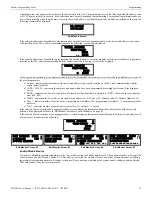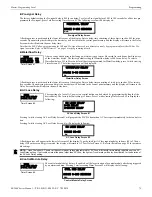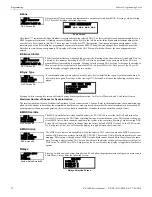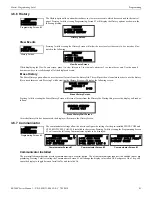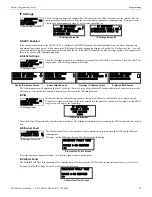
ES-200X Series Manual —
P/N LS10131-000FL-E:C 7/25/2018
71
Master Programming Level
Programming
Pressing the down arrow key will display additional screens for Zones up to Z99. Press the number key corresponding to the Zone to be
programmed. Screens will be displayed allowing the programmer to select Audio Messages 1 through 14. When an audio message is
selected, the display will return to the Zone Message screen, showing the message selected for that particular zone. In the example
above, Zone 001 has been programmed for Audio Message 1.
3.6.4 Loop Setup
Loop Setup allows the programmer to configure the SLC Loop for NFPA Class A or Class B wiring and to
select the loop protocol. Pressing
1
while viewing Programming Screen #2 will cause the following screen
to be displayed:
Class
To program the SLC Class for the selected loop, press
1
for Class, while viewing Loop Setup Screen. In the preceding example, the con-
trol panel is programmed for Class B SLC wiring as indicated by the
B
to the right of
Class
in the display. To change the wiring style,
press
1
to toggle the display to read
Class A.
Each press of the
1
key will cause the display to toggle between
Class B
and
Class A
.
Loop Protocol
Loop Protocol refers to the SLC loop mode of operation. Refer to “Wire Requirements” on page 143 for wire specifications based upon
SLC protocol. There are two Loop Protocols available:
•
CLIP (Classic Loop Interface Protocol) - which is used for the older legacy addressable devices such as the M300 Series modules
and detectors
•
LiteSpeed (factory default setting) - used for the 350 Series or newer addressable devices for quicker response times. Note that the
legacy devices can operate only in CLIP mode while the newer devices are compatible with CLIP and LiteSpeed modes of
operation
Pressing
2
while viewing the Loop Setup Screen will toggle between CLIP and LiteSpeed Protocols.
Device Addressing
It is important to note that the ES-200X addressable device capacity is 99 detectors and 99 control/monitor modules. Newer devices can
be set to addresses higher than 99 but these addresses will not function with the ES-200X.
Note that it is permissible to mix old and new devices on the same loop but the FACP must be set for CLIP mode when older devices are
installed.
3.6.5 System Setup
System Setup allows the programmer to configure the following control panel features:
•
Function Keys
: This feature allows the user to rapidly enable/disable various fire panel inputs and outputs during scheduled
maintenance.
•
Banner:
This option allows the user to change the top two lines of the LCD display from the blank factory default readout to a user
defined readout when the control panel is in Normal condition.
•
Time-Date:
This feature allows the programmer to set the time, display format (24 hr or 12 hr), date and daylight savings time
feature into the FACP memory
•
Timers:
This option allows the programmer to set the PAS (Positive Alarm Sequence) time delay, Pre-Signal time delay and
Waterflow time delay.
•
NACs:
This feature allows the programmer to configure the control panel Notification Appliance Circuits for a variety of options,
such as circuit type, silenceable/nonsilenceable, autosilence, coding, silence inhibit, zone assignment and enable/disable.
•
Relays:
This option allows programming of two onboard relays for activation by various control panel events, such as alarm,
trouble, supervisory, etc.
•
Canadian Option:
This option allows the programming of certain options to Canadian specifications.
•
Waterflow Silenceable:
This option provides the ability to silence any output circuit activated by a monitor module programmed as
a waterflow type.
•
MNS Override:
This option allows the Mass Notification System to override the FACP’s specified NACs and control modules.
•
Auxiliary Power
: This option configures the use of the 24VDC auxiliary power output at TB11 on the FACP.
•
Trouble Reminder
: This feature provides an audible reminder that an alarm or trouble still exists on the FACP after the control panel
has been silenced. The control panel piezo sounder will pulse once every 15 seconds during an alarm and every two minutes during
a trouble condition, after the Alarm Silence or Acknowledge key is pressed. The piezo will continue to sound at these rates until the
alarm or trouble condition is cleared. If the trouble condition is not cleared within a selected time of either 4 or 24 hours, the panel
will reactivate the trouble sounder and retransmit the trouble condition to the central station if connected. When used with SWIFT
wireless devices, the Trouble Reminder must be set to 4 hours.
PROGRAMMING
1=LOOP SETUP
2=SYSTEM SETUP
3=FUTURE USE
Programming Screen #2
LOOP SETUP
1=CLASS B
2=PROTOCOL LITESPEED
Loop Setup Screen
NOTE:
If the FACP reports an open fault on an SLC Loop programmed for Class A, the trouble condition will latch at the FACP. When the
SLC Loop has been repaired, the Reset button must be pressed at the FACP (at least 2 minutes after the trouble has been repaired) to
clear the SLC trouble.





